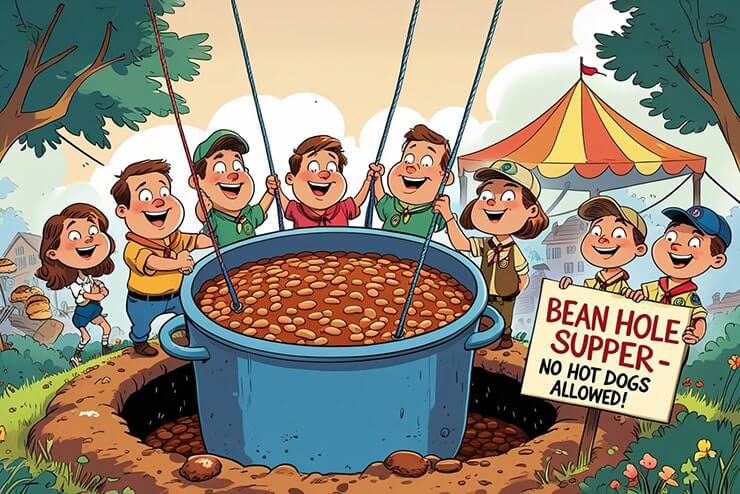Read by Matilda Longbottom

They say beans are the “musical fruit,” and well, we all know how that tune goes. Who could forget the iconic “Blazing Saddles” campfire scene where a group of cowboys turns a simple bean meal into an impromptu orchestra? As a kid, I cringed every time I saw some scruffy character on TV scooping up sloppy beans from a tin plate. Not exactly gourmet, right?
Growing up, my relationship with beans was…let’s call it lukewarm at best. My mom was a firm believer in their nutritional value—fiber, protein, minerals, and all that jazz—but no amount of “gussying up” with condiments could make me beg for seconds. Canned beans were canned beans, no matter how much ketchup or mustard she added. Fast forward to years later, I found myself on vacation in Harpswell, Maine, when fate—and hunger—introduced me to something called a Bean Hole Supper. Yes, you read that right: Bean Hole Supper.
It was the ‘90s and while driving down Route 123, I spotted a hand-painted sign advertising the supper. With four hungry kids and a husband to feed, I figured we’d get hot dogs or something… right? Wrong. Apparently, the township had voted against hot dogs. Who votes against hot dogs? My family groaned audibly when we learned that the $5 admission didn’t include any kind of meat product. Just beans. Sigh.
We lined up, plates in hand, hoping for the best. The Cub Scouts and volunteers manning the tables had clearly done this before—there were all the fixings: potato salad, coleslaw, pickles, and the pièce de résistance… beans! Now, these weren’t your sad, soggy, canned beans. Oh, no. These were slow-cooked for 24 hours in a firepit, Maine-style, in giant steel pots. Maine soldier beans, soaked and seasoned with molasses, salt pork, and secret spices, then buried like treasure in a 20-inch-wide, 13-inch-deep fiery pit. It’s practically alchemy.
Naturally, I whipped out my rented camcorder (this was the ’90s, remember) and asked the local bean expert for the lowdown. He chuckled, “You’re really filming the beans?” Yup. For posterity—and my Philly relatives, who would otherwise never believe me.
As I looked over to check on the kids, I noticed their faces had fallen. Just beans?! But their disappointment quickly turned to joy when they saw the dessert tent. Homemade pies, cookies, cakes—oh, my! Clearly, the townsfolk had anticipated the bean rejection phase. We sat down among the locals on a sunny Summer day, and to my surprise, those slow-cooked beans tasted like heaven. Who knew? The humble bean, when cooked for an entire day in a hole in the ground, could become an epicurean delight.
The tradition of the bean hole supper is as old as New England itself. Legend has it the Pilgrims started it, and rumor has it George Washington’s troops at Valley Forge survived, thanks to beans. They were also a staple in Maine’s lumber camps, keeping the workers hearty and warm during frigid Winters. Some serve them with brown bread; others go full Scottish or English and serve them at breakfast with toast. My Irish cousins think beans on toast is practically dessert.
The Harpswell bean hole supper is no more—the field is up for sale—but whenever I drive past, I can’t help but smile. The warmth of that day, the laughter of my kids (who may or may not have ditched their beans along the way), and the camaraderie of the locals made it unforgettable. Sometimes, it’s not about the food; it’s about the people. Sure, the beans were delicious, but the flavor of friendship? That’s something truly magical.
And to this day, I still think about those giant pots, the secret recipe of time and fire, and my dear friend who offered to scrub them clean at the end of the day. Because when it comes to community, even a humble bean can create something extraordinary.
Because sometimes, all it takes is a bean and a dream. ❖
About the Author: Hannah Dougherty Campbell, a spirited wordsmith with a heart as lush as her garden, hails from the suburbs of Philadelphia. Inspired by the beauty of nature and the resilience of the human spirit, Hannah found solace and creativity in crafting heartfelt poetry. With a background in teaching and a passion for nurturing creativity, she imparts her wisdom through her creative-writing classes, where she encourages others to explore the depths of their souls through the written word. Her cherished tradition of assigning flowers to personalities has blossomed into a family heirloom, enriching the lives of her loved ones and students alike. Through her work, she reminds us all of the delicate dance between nature and humanity, where every petal tells a story and every soul blooms in its own unique way.


 Previous
Previous

